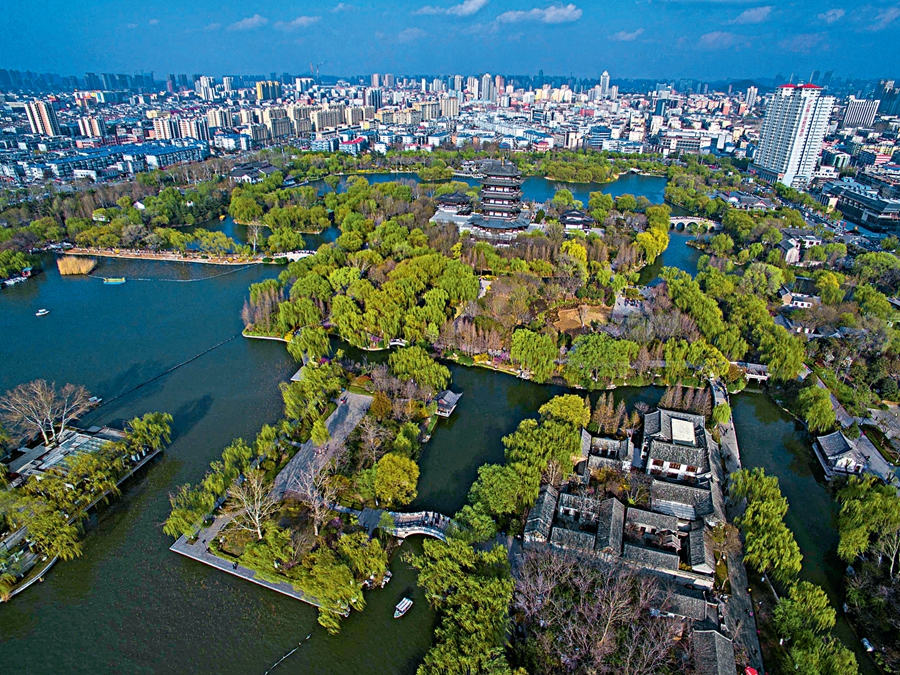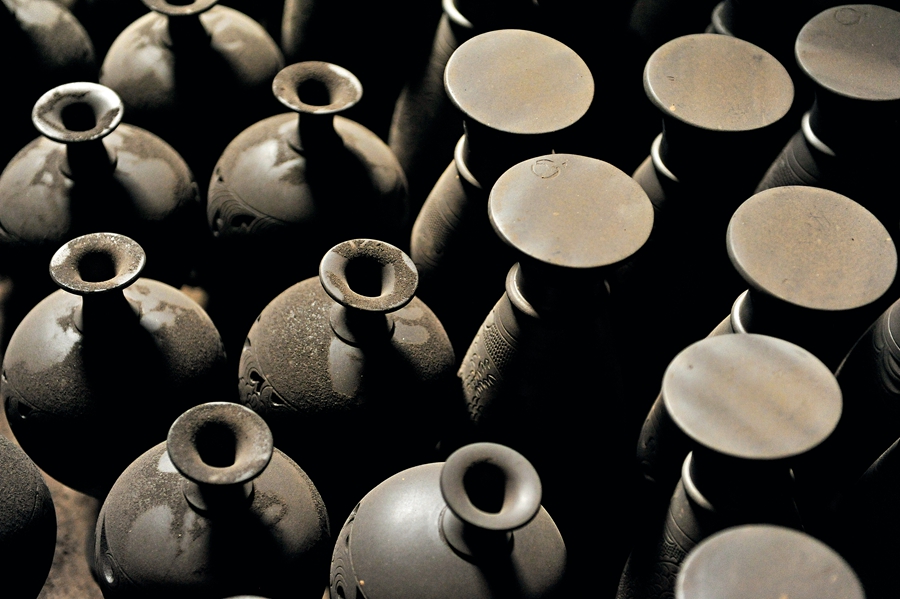JINAN, capital city of Shandong Province, boasts a history of more than 2,600 years. The main site of Longshan Culture, one of the major cradles of Chinese civilization, was discovered to the east of Jinan.
The name “Jinan” literally means “south of the Jihe River.” Although the river no longer exists today, underground water resources in the city remain abundant. Therefore, Jinan is famous as “the city of springs.”
Winter in Jinan by renowned Chinese writer Laoshe is familiar to generations of Chinese people as it was selected for a middle school textbook. With merely 800-plus characters, the beautiful prose vividly depicts winter in this city – mild and sunny.
Ancient Culture
A museum of the Longshan Culture is situated in Zhangqiu District which can be reached in about a 30-minute ride from Jinan. Relics such as black pottery items, oracle bones, stone arrowheads and axes, rammed earth ramparts, and so forth showcase a Neolithic culture.
The site of Longshan Culture was first discovered on April 4, 1928 by a college student Wu Jinding who later became an archeologist. During his field trip, Wu happened to see an elevated region that is three to five meters above the land in Longshan Town. Through pottery pieces, shells, and animal bones covered by layers of dust, Wu found out that it is the ruins of a prehistoric settlement.

The Daming Lake after rain, March 26, 2017.
He returned to the site three months later. An intact stone axe and some black pottery pieces that had never been seen before were unearthed this time. Wu’s findings received great attention from archeological circles. As more pottery and stone wares were raised up out of the ground, a Neolithic civilization dating back about 4,500 years was revealed. Noted for its highly polished black pottery, the culture was named Longshan after its geographic location.
It is the first significant Neolithic culture discovered by Chinese scholars and one of the research highlights of China’s prehistoric archeology. Before that, painted or red pottery wares containing much sand had been seen a lot among unearthed relics in China. But the pottery pieces unearthed in Longshan are usually black or dark grey with a fairly smooth surface, and are in shapes of cups, plates, jars, and cooking containers.
Some of the black potteries are as thin as eggshells, which require sophisticated techniques and a kiln temperature of as high as 1,000 degrees centigrade to manufacture. Representing a high level of skills in pottery making, the eggshell black pottery is not easy to produce even in the present day, let alone for our ancestors over 4,000 years ago.
Other than black pottery wares, archeologists also found fine polished stone knives, shovels, chisels, and tools made of bones. It was to the excavators’ surprise that oracle bones similar to those unearthed in the Yin Ruins in Henan Province were found at the Longshan Culture site as well. However, no signs were made on these animal shoulder blades.

Some black pottery pieces of the Longshan Culture.
Research and excavations carried out in the following decades have eventually ascertained that it used to be a settlement in the Longshan Culture period. Covering an area of 200,000 square meters in a rectangular layout, the settlement was fairly large in size in the prehistoric period.
First constructed around 2000 BC, the settlement existed and expanded all through the centuries until the Zhou Dynasty (1100-256 BC). Residents mainly relied on agriculture, supplemented by cattle breeding, fishing, and hunting. Handicrafts were rather well developed and metallurgy was emerging. Small bronze wares and materials for bronze smelting have been dug up too. The Longshan Culture has brought an unknown history to light. It was later known as the Longshan Age.
Plentiful Springs
Surrounded by mountains on three sides, Jinan is located on a basin-like land with a unique geological structure and rich underground water resources. Not many cities in North China are endowed with such a great number of springs.
Springs not only bring vitality to Jinan, but also integrate into the city’s scenery and history. Time-honored streets and alleys can be compared to bones to Jinan. Springs scattered across the city are akin to its soul – unceasingly nourishing every piece of land.
Since ancient times, Jinan has been famous for its 72 springs. However, the actual number far surpasses this figure. Incomplete statistics show over 300 springs in the old town whose area occupies 2.6 square kilometers. Except the well-known Baotu Spring, the Pearl Spring, and the Black Tiger Spring, most have never been named. Counting those in suburban areas, Jinan possesses a total of 733 springs. They bubble up out of the ground and flow into rivers and lakes. Over the centuries, springs have played an irreplaceable role in people’s life in Jinan while forming a background for numbers of compelling stories.
What’s more, the springs are of different kinds. Some are gushing while some are cascading gracefully. Some look like arms of lakes and some resemble strings of pearls. Several of them even sound like a tiger’s roar. Numerous poems and pieces of prose eulogizing the springs have been left behind by generations of writers. Diversified folk activities on the theme of springs prevail in the city.
Fed by springs, the Daming Lake is a natural landmark and is praised as a “pearl of the city of springs.” Spring water flows in from the south bank and flows out from the outlet on the north bank when the lake is full. Water does not seep through igneous rocks at the bottom of the lake, which maintains the lake water at a certain level throughout the entire year regardless of rainy or dry seasons.
There are many exquisite ancient buildings around the lake. Besides, six islets scatter in the lake. It looks picturesque in which boats are drifting on glistening water, birds are flying overhead while fishes are swimming under ripples, and lotus and willows are blooming on the banks. The lake looks more appealing against the background of the Qianfo Mountain nearby.
Centuries-old Cuisine
Other than amazing scenery, delicious food is also one of the highlights of trip to Jinan. Local cooking style belongs to the Lu Cuisine.
China’s culinary landscape boasts long history and great culture. Lu Cuisine takes the lead in terms of influence and cultural profundity. It is believed that Confucianism originating from Shandong has not only developed the collective personality of Chinese people, but also shaped their views on diet. Confucius was a philosopher, an educator, and a gastronome. In the Analects of Confucius, his opinions on health, seasoning, dietetic hygiene, cooking temperatures, skills of cutting, and table manners can be found. In addition, The Book of Rites, a Confucian collection describing social norms and ceremonial rites, records some standards for food ingredients, cooking methods, and seasoning. It can be observed that most of the earliest culinary theories in China stemmed from Shandong which set a solid foundation to develop into the local Lu Cuisine.

A cooking contest of Shandong cuisine is staged in Jinan on January 17, 2018.
The history of Lu Cuisine can be traced back to the Spring and Autumn Period (770-476 BC). It grew into a representative of northern China’s cooking after the Song Dynasty (960-1279). In the Ming (1368-1644) and Qing (1644-1911) dynasties, it became the dominant cooking style of the imperial court. In Manchu Han Imperial Feast – the grandest traditional Chinese meal – Lu Cuisine takes up the majority of the menu. Its fresh and salty flavor has greatly influenced the dietary habits in northern China, particularly in Beijing and Tianjin.
Shandong neighbors the Bohai Sea and the Yellow Sea. As a result, seafood of exemplary quality is a major component of Lu Cuisine which is inclined to keep the freshness of ingredients. Sea cucumbers, abalones, fish skins and so forth are usually made tastier by cooking with soup stock. Furthermore, every kind of ingredient – from meat to fruits and grains – are nicely matched. Moreover, the principle of balance in traditional Chinese philosophy is embodied in the ways of blending sugar, vinegar, and sauce as well as controlling cooking temperatures to ensure mouth-watering colors and taste.
Scallions can be found in many recipes of the Lu Cuisine owning to Shangdong people’s fondness of this vegetable. For instance, Peking roast duck is always served with sliced scallions to make the meat more delicious. Fried sea cucumber and fried beef tendon are seasoned with a great deal of scallions. It is also an essential ingredient for making meat filling and cold dishes. Zhangqiu is especially noted for quality scallions.
(Complied by China Today)